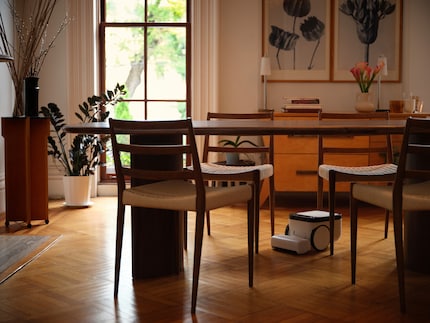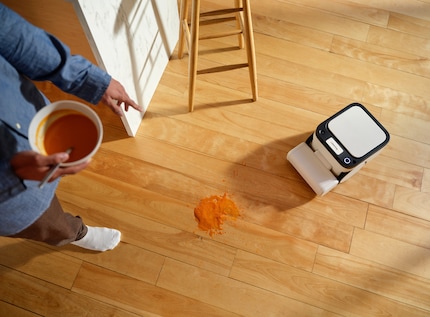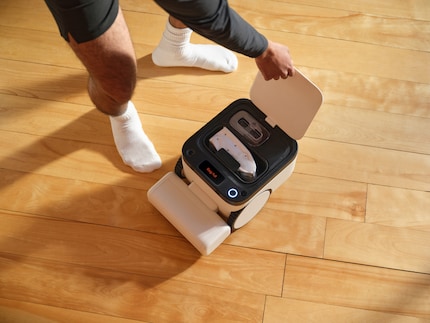
Product test
Dyson 360 Vis Nav review – superb cleaning with initial difficulties
by Lorenz Keller

The Matic robot hoover is supposed to be better than all the others. The developers, who used to work at Google Nest, have made bold decisions - and not just in terms of price.
Matic is the name of the new robot hoover from the USA, which can already be pre-ordered on the start-up's website and will be launched on the market next spring.
It was developed by two former Google engineers who worked on cameras and smart doorbells at the subsidiary Nest. In an interview with "The Verge", the founders are confident: after six years of development, the robot should be better than all the others.
And it has to be, because even the pre-sale price of 1,500 dollars is 300 to 500 dollars higher than most top models from other manufacturers. The Matic will then go on sale in the USA in March 2024 and will cost 1800 dollars. That is significantly more expensive than the current price leader, the Dyson 360 Vis Nav, which I recently tested in detail.
In addition to the high price, there is another thing they have in common: both Dyson and Matic rely primarily on cameras for navigation. In fact, this is the big speciality of the new product from the USA.
There are five built-in cameras. They are designed to create a 3D map of the surroundings, similar to Google Streetview. The robot vacuum cleaner then rolls through the home like a self-driving car and recognises every obstacle: Chair legs, cables, children's toys, shoes and so on. The manufacturers promise: In 10 out of 10 cases, the robot navigates precisely from A to B.

Exemplary: the entire calculation and creation of the map takes place on the device itself. So you don't even need an internet connection to operate it. And the start-up also promises that no data is sent to the cloud. The robot can vacuum on the one hand, but can also pick up damp and even clean liquids on the other. As it also recognises dirt with its cameras, it switches seamlessly between cleaning methods. Carpets are also recognised, of course.
It will be interesting to see how the Matic copes with dark rooms and dirty cameras. Problems that Dyson still has to solve with camera navigation.
The appearance of the Matic is very different to other robot hoovers. It looks more like it is dragging the suction station along with it: an angular box with two large wheels and a suction arm at the front.
The robot has space for a large battery: 2.5 hours of vacuuming or even three hours of mopping are possible. With a height of 20 centimetres, Matic will struggle under sofas or beds. Another similarity with Dyson, which also relied on a high design for the first generation of its robot vacuum cleaner - and was heavily criticised for this.

The camera technology enables gesture recognition to issue commands. You can also give the robot instructions by voice: "Matic, please clean here!" or "Matic, please wet the bathroom!" The Matic is supposed to drive around automatically every few hours and search for dust and dirt. It also learns household habits and always cleans the kitchen after dinner, for example.
When the dust bin is full, Matic parks right next to the waste bin and sends you a notification. You can now remove the dust bag and dispose of it. It should last for a week to a month - depending on how often you vacuum and, above all, how much liquid you want the robot to pick up.

This is because the liquid also goes into the "dust bag" and is bound there by special crystals. The advantage of this design is that you only have to dispose of one bag - and the entire design is HEPA air filter-certified.
Of course, you have to buy the special bags separately. Matic wants to sell you a plan for 15 dollars a month, which gives you unlimited bags and replacement brushes as well as an extended warranty. It is unclear how much the bags cost individually.
In Europe in particular, the manufacturer is likely to have a difficult time with this business model. This is because most users do not find an additional plan at an expensive cost price acceptable. And the dust bag also runs counter to the trend towards bagless hoovers. Overall, as an expensive newcomer, the Matic has to clean significantly better than the competition to stand a chance on the market.
Cover photo: Matic
Gadgets are my passion - whether you need them for the home office, for the household, for sport and pleasure or for the smart home. Or, of course, for the big hobby next to the family, namely fishing.
From the latest iPhone to the return of 80s fashion. The editorial team will help you make sense of it all.
Show all